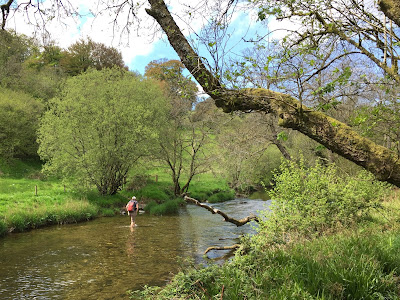We first visited Exmoor in 2012. The Queen's Diamond Jubilee celebrations were in full swing - and we were hoping to avoid the whole shebang - so we headed for somewhere to put us out of the way of the festivities. Rocking up at a cracking little campsite at Halse Farm, which sits just below the moor line on Winsford Hill, Exmoor.
Halse Farm Caravan and Camping Site
On our first walk out from the campsite we witnessed the strangest of sights - a small bristling tree line moving itself along the horizon of a nearby hill - probably Withypool Hill (?). I remember watching in complete astonishment - as the wood headed up towards the top of the hill. Finally a tractor emerged from beneath it, and a trailer. Back at the campsite I remarked upon the scene to the Farmer - and she replied enigmatically:
"I look'd toward Birnam, and anon, methought, The wood began to move".
The coming Monday was the night of the Jubilee beacons. Winsford Hill had its own beacon. So early on the evening of the 4th June, whilst we sat outside the tent drinking a local rough scrumpy; the campsite emptied - campers and villagers alike were heading upwards to the celebrations. It dawned on us - that we would be missing "An Historical Event of Landscape Scale". So we followed the crowd and were not to be disappointed.
 |
| Winsford Hill Beacon 4th June 2012 |
As the Winsford Hill beacon flared .. the crowd cheered; And as the beacons were lit across the whole of Exmoor - a local man called out the name of the hill upon which they stood - to further cheers from those assembled around him. He then named the distant fires - of Dartmoor, of Bodmin Moor, of the Quantocks, of the Brecon Beacons, of the Blackdown Hills - and again we cheered believing that we too could see as far.
On our second visit to Exmoor - the celebration was a humble birthday. For the first half of the trip we were joined by R, whose local knowledge lead us to explore sites we may otherwise have missed.
Our first day was spent at Horner Wood - looking for wood warbler (
Phylloscopus sibilatrix), redstart (
Phoenicurus phoenicurus) and pied flycatcher (
Ficedula hypoleuca). It didn't take us long to find the first of the three - with an obliging wood warbler in song by the car park at Webber's Post, even as we tied our boots on.
The other two bird species remained elusive, but we eventually found them, and spent quite some time in a small glade - with a male pied flycatcher moving in endless song and circle in the tree canopy above us.
 |
| Pied flycatcher - Horner Wood |
On Sunday we headed to Lorna Doone Valley - where we encountered both pied flycatcher and common redstart, the former again treating us to extensive and eye-wateringly close views as a male sang from a path-side tree.
The twisted, moss covered trees growing out of the clitter strewn slopes of the valley are reminscent of Wistman's Wood - although they lack perhaps the magickal resonance of Dartmoor's sacred grove?
Heading out onto the open moor - we connected with our target species - whinchat (
Saxicola rubetra) - a bird I had only ever previously seen on migration - but here was an individual (or two) on breeding territory! I failed miserably to make any sense of the bird with the camera - a problem I also experienced with an obliging but distant male cuckoo (
Cuculus canorus).
I had also wanted to reacquaint myself with some of the ancient stones that we had seen on our 2012 trip - especially as I had inexplicably lost the photos of all the monuments. So, on the drive back from Lorna Doone Valley we made a detour to the moor above Porlock to visit its small stone circle and the nearby microlith double stone row.
Both these sites are difficult to photograph due to the low lying nature of the stones within them - but they still hold the attention of the observer. The double stone row was longer than we had realised on our first visit - with R finding a further set of stones some metres on from where we had previously thought that the lines had ended. the line drawing of the Porlock complex in Riley and Wilson-North (2001) Fig 2.12. p.27 only adds further confusion to my recollection and experience of the site.
 |
| within / without the stone circle |
 |
| Attempts to photograph the micro-lith double stone row |
Later that night, A and I took a slow bat walk up the lane to the Caractacus Stone, watching and listening to common pipistrelle (
Pipistrellus pipistrellus) as they foraged along the hedgerows.
Distant tawny owls (
Strix aluco) called mournfully from the woodland below. A shrill call alerted us to an approaching Barn owl (
Tyto alba) which flew down the centre of the road before swerving left in front of us and heading out across the fields. A cracking end to a long and very enjoyable day!
 |
| The Caractacus Stone |
This early medieval stone bears the inscription CAARCHI NEPUS which Riley & Wilson-North (
ibid) tell us translates as "kinsman of Caractacus" - a reference to genealogical descent from a 1st Century British rebel.
References
Riley, H. & Wilson_North, R. (2001)
English Heritage, Swindon































































